Navico Halo24 & Raymarine Quantum2 radars, Gizmo goes full Doppler
Credit to the schooner Mary Day for lighting up Camden Harbor nights with her Christmas tree main-topmast, but yesterday Gizmo became the rare vessel equipped with four different solid-state Doppler pulse compression radars. Given the Simrad Halo24 announced in October, and the Raymarine Quantum 2 introduced last February, all four major marine navigation electronics brands now offer this valuable technology. And while the timing isn’t ideal, I’m excited about adding the two new radomes to the Garmin Fantom 24 and Furuno DRS4D-NXT Doppler models already being tested.
Actually, near-freezing air temperatures do sharpen a guy’s appreciation for design details that lead to fast, easy installs. In the case of swapping the Simrad Halo24 with the 4G radome radar that I began testing in December 2011 (yes, the timing has often been chilly), it would have been quite easy if I had had the little 3G/4G to Halo converter cable. But I was able to attach the single data/power cable while still inside Gizmo’s cozy cabin, which was appreciated as the four little screws that effectively fasten those two cable strain relief straps could be a hassle even in certain warm conditions (like when up a mast).
Incidentally, the Halo24 — like the Halo open-array radars introduced in 2015 — has LED accent lights, though they’re hard to see in the little steps on both sides of the cable port. They glow blue apparently, and I look forward to seeing the effect (though they can be turned off if that’s your preference).
I’m impressed with Navico’s latest system for converting a standard RJ-45 Ethernet plug to their own (orange) more secure and waterproof marine version. The plain RJ-45 and bare power wires should be fairly easy to fish around a boat, and then it’s just a matter of getting the fittings and gasket in the right order to achieve a waterproof and compact connection. In fact, it’s compact enough to fit through Gizmo’s existing flybridge hole and cable gland, so I was also able to complete this task in warmth.
Thankfully absent from the Halo24 install requirements is the Navico (Ri10) interface box needed for 3G/4G MARPA and chart overlay. So besides losing the module itself, Gizmo gained a spare NMEA 2000 network connection and a 12v power feed, though I did have to reroute the new Ethernet plug.
The Halo24’s backside label indicates that the Simrad, B&G, and Lowrance models are essentially the same, though that doesn’t necessarily mean that a user will see the same radar features on the different brands’ various multifunction display models. Note too the red LED Status light, which can indicate various conditions like low voltage, no Ethernet connection, or operating normally.
It was wonderfully easy to swap the Raymarine Quantum 2 with the original Quantum Q24 first tested in late September 2016. That’s partly because the Q1 to Q2 is less of a solid-state radar tech jump than Navico made moving from FMCW 3G/4G to pulse compression Halo24, so I could use the same pair of data and power cables already fished up Gizmo’s mast. But it’s also because those cable connectors and the strain relief bar don’t require tools (even with a gloved hand).
Coincidentally, my first Garmin Fantom 24 testing was also in late fall Maine (though I had already been impressed with the Furuno DRS4D-NXT’s Doppler features that summer). But it’s been unseasonably cold here — 18°F at almost noon today — so I’m not sure when I’ll get underway to compare all this radar goodness, or if there will be moving vessels beyond the Maine State Ferries.
Also, I’m not sure that the Halo24 is completely working with Gizmo’s NSS Evo2 displays yet; it’s recognized only as “unknown radar” and, though running, some feature controls aren’t operable. Maybe a software update is in the works, or maybe I missed an install step; inquiries will be made. {Ahem… operator error, see PS below}. But meanwhile, the Axiom 7 fully recognized the Quantum2 on startup and I was surprised when the default Doppler mode showed a close target coming my way from the port quarter in what seemed like a dead quiet Camden Harbor.
- Raymarine Quantum 2 Doppler seeing waterfall motion
- Camden Inner Harbor waterfall area with small buoy
- Q2 in true color mode instead of Doppler moving target detection
- Navico Halo24 radar first try (as “Unknown Scanner”)
The moving target was the waterfall (that you can also see a bit of in the top photo), and while the waterfall is not moving across the ground, the water sure is (and the resulting current has already taken out one Gizmo fender). It’s an impressive example of how Doppler radar pings can instantly detect target motion even in the severe noise created by a steep, rocky shoreline and buildings. I also saw the Quantum 2 highlight a moving car in the Public Landing parking lot today.
Note how Ray’s Q2 images two relatively small buoys (toward the waterfalls) in true color mode but not in the muted Doppler mode background, and the Halo24 images them even better. But I don’t think I’m seeing all that the Halo24 has to offer yet. My guess is that these are both very capable modern radars and I look forward to more testing.
PS 12/9/18: It turns out that the issues I was having with Halo24 yesterday were not because of a software update that’s about to come out; Gizmo’s system needed Version 18.2 that was released in September, and that yours truly only thought he’d applied. Behold the difference:
- Navico 18.2 update supports Halo24
- Halo24 Doppler identifies Camden waterfall despite flybridge obstructions
- Halo24 true dual range showing on 7-inch NSS Evo2
- Halo24 dual range and dual overlay
It was easy to update the NSS Evo7 using an SD card — and might have been even easier over WiFi — and the MFD immediately recognized the Halo24 on the network. In fact, it saw two Halo radars because that’s one way that Navico expresses the true dual range nature of models like the 4G and the two Halos. And, sure enough, the Halo24 Doppler (called Velocity Track) identified the Camden waterfall much like the Raymarine Quantum 2 can, and the Halo is at a disadvantage given the aft obstructions that go with its flybridge mount.
On the third screen, I’ve used dual range to better illustrate the Halo’s limited ability to see aft through the Gizmo’s gaggle of flybridge electronics. Note how the two ranges are using different color pallets and how I’ve turned up the gain on the 300-foot range to improve imaging aft. Navico’s dual range really is like having two radars and there may not be another system that can show dual range radar simultaneous with dual radar overlays. And that’s on a 7-inch evo2 that’s a generation old.
I’ve also heard that Navico is close to offering Doppler-assisted ARPA — that’s automatic tracking, no manual target picking required — on the Halos, and I was suprised yesterday to discover that Raymarine already has. That means that Halo and Quantum may be in reach of what I find so outstanding and useful about Furuno NXT radar. Both these new radars seem to have serious horsepower.



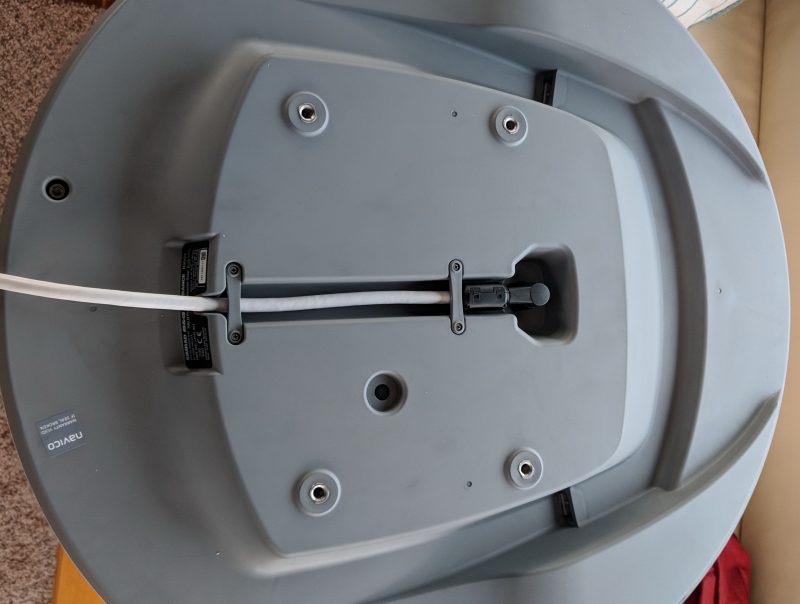











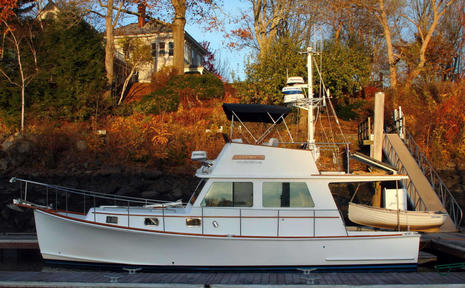
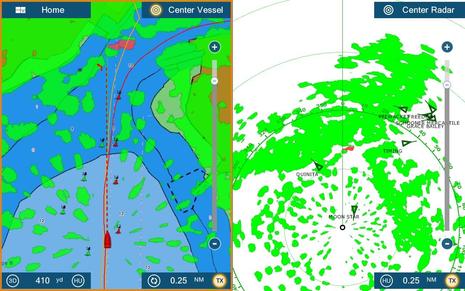
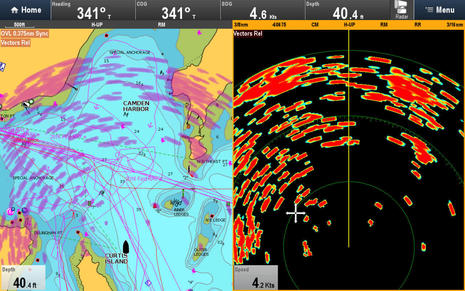
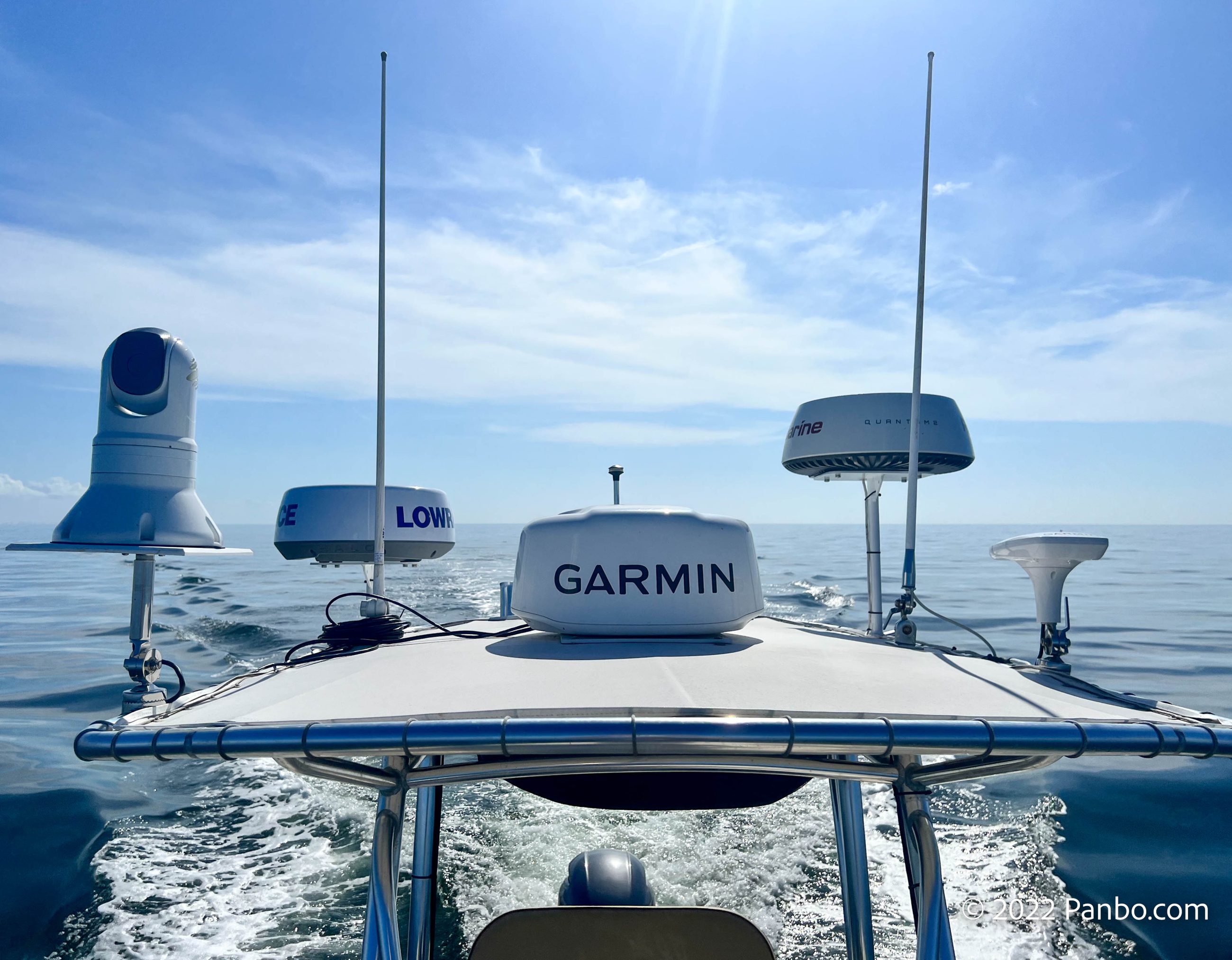








I’m thinking you could spot empty tables at Marriner’s with that setup.. 🙂
It might be useful if you came back up and walked briskly along the shore near the waterfall, maybe flapping your arms. I don’t understand where everyone went.
Hmm – I think most of ’em are anchored around here, showing off their new sunburns and complaining about the heat.. (and the honkin’ SE wind which is keeping ’em on this side of the Stream)
I like the ability to run std rj45 end and then waterproof it when connecting. It’s hard work routing modern cabling in older boats that were never designed to have any decent cable groups.
I’m hoping that there is an 18 inch Halo in the works. The 24 inch dome is a bit large for my sailboat as it would likely interfere with the stay sail. I was ready to buy a 4G this past fall when I bought the rest of my new B&G electronics, but when I saw the Halo24, I decided to wait for a 18 inch Halo.
I’m hoping there is an 18 inch Halo in the works. The 24 inch dome is a bit large for my sailboat as it would likely interfere with my stay sail. I was ready to buy a 4G this past fall when I bought the rest of my new B&G electronics, but when I saw the Halo24, I decided to wait for a 18 inch Halo.
Ben- Do you still feel that the NXT stands above the rest?
Happy New Year, Howard!
And, yes, I still think that Furuno NXT stands significantly above the rest. It the NXT “Fast Target Tracking” and “Auto Target Acquire” that no other manufacturer has been able to duplicate (yet). I have gotten out once with all four current Doppler radomes and while Raymarine and Simrad have at least equaled the instant moving target highlighting that Garmin and Furuno simultaneously trail blazed, I don’t think that’s as useful in most situations as the fast, intelligent, and precise auto tracking that NXT can do.
The competition does do manual tracking (MARPA) pretty well and Raymarine Q2 now has fast auto tracking in guard zones — though it doesn’t seem to differentiate between fixed and moving targets — and I also hear that Halo radars will soon get auto tracking. But NXT puts the bar high; I’m still amazed at how often and quickly it can generate target vector info that almost exactly matches the AIS speed/course data the same target is transmitting or how a small, fast boat is actually moving, and how rarely it tracks fixed targets (though it does sometimes pick up flying birds or big wakes).
NXT can also display a CPA (Closest Point of Approach) graphic for a particular crossing situation (and so can a Raymarine Quantum). I guess that Furno and the other manufacturers are shy about calling these features ARPA because that implies adherence to a strict IMO commercial radar standard, but they sure can provide recreational boaters with ARPA-like aid with collision avoidance.
Hi Ben,
Is there any news on an 18″ Halo?
Sorry, Barry, I have not heard of an 18″ Halo radome in works, and I’m not sure there’s much chance of one. All the solidstate radomes are lighter and much more power efficient than similar size magnetron radars, so all you get with an extras small model is less physical size and possibly lower performance. Raymarine, Navico, and Furuno have not yet offered solidstate radomes in two sizes. Only Garmin does, but I rarely see the smaller one, and its 24 is actually the largest though it’s not a better performer in my experience.
Incidentally, declared radome sizes may mean antenna width, dome diameter, or who-knows what:
Simrad, B&G, Lowrance Halo 24: 24-inch diameter, 8.9 h, 14.9 lbs
Simrad, B&G, Lowrance 3G/4G: 19.3-inch diameter, 11 h, 16.3 lbs
Garmin Fantom 24: 25.4-inch diameter, 9.8 h, 21 lbs
Garmin Fantom 18: 20-inch diameter, 9.8 h, 13.6 lbs
Raymarine Quantum 18″: 21.3-inch diameter, 8.3 h, 12.3 lbs
Furuno DRS4D NXT: 24-inch diameter, 8.7 h, 16.1 lbs
Are the Halo24 radars safe to humans in close proximity? I can’t find any details on the safety of this. Navico mentions it for 3G/4G, but not for the new Pulse Compression.
Hi Robert, the Halo24’s “Radio Frequency (RF) Exposure table” is on page 5 of the installation menu:
https://ww2.simrad-yachting.com/Root/Simrad-Documents/halo24/Halo_24_IM_EN_988-12307-001_w.pdf
So the “System 100 W/m2 occupational safe distance” = 0.6 m (2.0 ft)
And the “10 W /m2 public safe distance” = 2 m (6.6 ft)
It’s always struck me as a bit strange that boat crew can somehow safely get closer to a radar than passengers can, but that’s how the standards are written.
At any rate, this is quite a safe radar, though not quite “huggable” like the original Navico solid state Broadband, and I suspect its safe distances are very close to all the other solid state pulse compression radomes I have mounted.
https://panbo.com/navico-broadband-radar-truly-safer/
Any rumors on Furuno’s entry level Wifi radar regarding a possible solid state upgrade any time soon ?
Thanks and best, Jan
So… June in Maine was unusually foggy and rainy. On Bliss we have a halo 3′ open array radar that made long passages in near 0 visibility possible. This year we came to Maine after purchasing the $500 VelociTrack (Doppler) option offered by Simrad.. And I have to say that the feature paid for itself while traveling by Booth bay about 2 weeks ago in dense fog.
On our halo normally we see a pile of red targets created by fishing boats, islands, and boys. Without doppler its hard to know what is what unless you use marpa to follow all the targets. This is a time consuming operation that was part of our Operating procedure in the past.
This year with Doppler we enabled the incoming only target feature (we don’t care about things going away from us.. only those approaching) and only worry about the “yellow” targets. The red targets are stationary or slow moving while yellow indicates that there is a vector moving towards you at some speed.
So… now we look for yellow targets and when we see it we tag it with marpa and follow it.
Back to Booth bay… It was really foggy… on the Radar we saw a yellow blip… we then tagged it with marpa and followed it.. we noticed that the target was approaching at a SOG of 10 knots with a relative closing speed of 17 knots… i.e. coming towards us fast. Marpa then warned us of an imminent collision. So.. we swung to STB 90 degrees and started blowing our horn..
And out of the mist we saw about a 45′ blue hulled please trawler without Radar or AIS appear out of the fog…
So… doppler and marpa saved the day.
If you travel in fog then the $500 for the feature is absolutely worth it in my book.
–luis